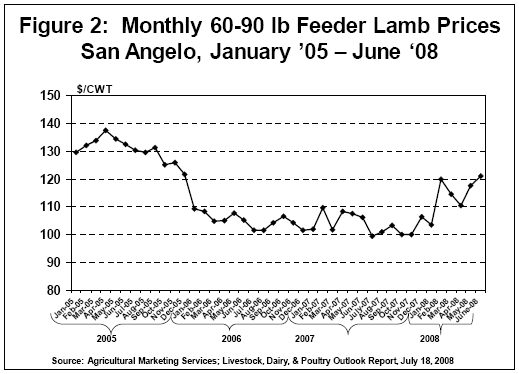AG-ECO NEWS
Vol. 24, Issue 21, August 6, 2008 – PDF version
Jose G. Peña
Extension Economist-Management
U.S. Mid-Year Sheep and Goat Inventory: Sheep Are Being Replaced By Goats At Almost 2:1 Basis
USDA’s mid-year Sheep and Goats report, released on July 25, 2008, indicated that while the U.S. sheep and lamb inventory dropped about 3.3 percent from a year ago, the U.S. all-goat inventory increased by close to four percent. Sheep are being replaced by goats at almost a two-to-one basis.
The U.S. sheep and lamb herd totaled 7.35 million head on July 1, 2008, down 250,000 head (3.3%) from an inventory of 7.6 million head on July 1, 2007, (See Figure 1). The U.S. all goat inventory, increased 135,000 head (3.8%) to 3.73 million head from an inventory of 3.595 million head a year ago (See Table 1).
| Table 1. Goats: Number by Class, United States, July 1, 2005-2007 |
||||
| 2006 | 2007 | 2008 | %CHG. | |
| Angora | 285,000 | 260,000 | 230,000 | -11.5% |
| Milk | 320,000 | 335,000 | 350,000 | 4.5% |
| Meat | 2,860,000 | 3,000,000 | 3,150,000 | 5.0% |
| All | 3,465,000 | 3,595,000 | 3,730,000 | 3.8% |
While the inventory of angora goats declined by 30,000 head (11.5%), it is interesting to note that the inventory of milk and meat goats increased by 15,000 head (4.5%) and 150,000 (5.0%), respectively. So, it appears that meat goats are replacing sheep at an unprecedented rate.
Prior to last year’s slight decline, the size of the sheep and lamb herd had increased for two years after eleven years of steady declines. The size of the sheep herd at 7.35 million head is now the lowest since the mid-1940. Two years ago, it appeared that the size would stabilize at about 7.7-7.8 million head as the main commercial sheep product focused on lamb production and became less dependent on wool production. This shift appeared supported by a shift to more hair sheep. It now appears that the residual effects of the ‘05-‘06 and this past fall/winter/spring drought, the termination of ewe lamb retention program, an increase in predation control problems, high energy costs and the softening of lamb markets in 2007 combined to influence individual decisions to continue to thin their sheep herds.
Lamb Market
The lamb market had been showing improvement since mid-2002 with prices reaching record highs in 2005 as the total U.S. sheep and lamb inventory continued to decline. Feeder lamb prices at San Angelo remained fairly strong throughout 2005. While market prices remain attractive, improving during 2008, prices remain slightly lower than 2005’s record highs (See Figure 2). The market for feeder lambs is expected to continue to improve as feeder lamb supplies remain relatively tight. 
Lamb Crop Down
The 2008 lamb crop is expected to total 3.97 million head down about 80,000 head (2.0%) from a lamb crop of 4.05 million head in 2007, with 88 percent of the lambs born prior to July 1, 2008. An additional 490,000 lambs are expected to be born during July through December 2008. Tight supplies of lambs, appears to indicate that the market will remain relatively strong. Keep in mind that while feeder lamb prices are slightly lower than 2005’s record highs, prices remain significantly above the 2000-04 average.
Breeding Herd Down
The breeding sheep and lamb’s inventory on July 1, 2008 at 4.42 million head was down 2.6 percent from July 1, 2007. The breeding herd consisted of 3.62 million ewes one year old and older, 180,000 rams one year old and older, and 620,000 replacement lambs (including newborn lambs). (See Table 2). The inventory of market sheep and lambs (including newborn lambs) at 2.93 million head, was down 4.2 percent from a year ago. The inventory of market lambs at 2.855 million head was down 4.7 percent from a year ago and consisted of 1.67 million lambs under 65 pounds, 595,000 lambs 65-84 pounds, 340,000 lambs 85-105 pounds and 250,000 lambs over 105 pounds. The market sheep inventory was 75,000 head.
| Table 2. U.S. Sheep, Lamb, Breeding Sheep and Lamb Inventories – July 1, 2007-2008 | ||||||
| All Sheep and Lamb Inventory (1,000 head) | ||||||
| 2007 | 2008 | ’08 as % of ’07 |
||||
| All Sheep & Lambs | 7,600 | 7,350 | -3.3% | |||
| Breeding Sheep & Lambs | 4,540 | 4,420 | -2.6% | |||
| Market Sheep & Lambs | 3,060 | 2,930 | -4.2% | |||
| Market Lambs | 2,995 | 2,855 | -4.7% | |||
| Ewes | 3,710 | 3,620 | -2.4% | |||
| Rams | 185 | 180 | -2.7% | |||
| Replacement Lambs | 645 | 620 | -3.9% | |||
| Total Breeding Sheep & Lambs 1996-2008: | ||||||
| 2003 | 2004 | 2005 | 2006 | 2007 | 2008 | ’07 as % of ’08 |
| 4,610 | 4,545 | 4,655 | 4,635 | 4,540 | 4,420 | -2.6% |
| 1996 | 1997 | 1998 | 1999 | 2000 | 2001 | 1992 |
| 6,170 | 5,775 | 5,575 | 5,350 | 5,030 | 4,900 | 4,780 |
